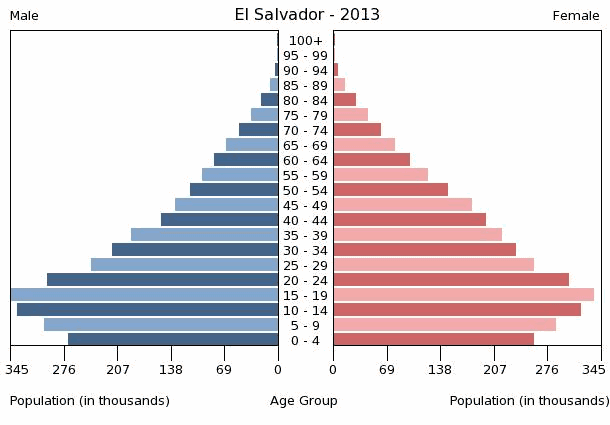Nationality:
Noun: Salvadoran(s)
Adjective: Salvadoran
Ethnic Groups:
Mestizo 86.3%, White 12.7%, Amerindian 1% (2007 census)
Languages:
Spanish (official), Nahua (among some Amerindians)
Religions:
Roman Catholic 57.1%, Protestant 21.2%, Jehovah’s Witnesses 1.9%, Mormon 0.7%, Other Religions 2.3%, None 16.8% (2003 est.)
Demographic Profile:
El Salvador is the smallest and most densely populated country in Central America. It is well into its demographic transition, experiencing slower population growth, a decline in its number of youths, and the gradual aging of its population. The increased use of family planning has substantially lowered El Salvador’s fertility rate, from approximately 6 children per woman in the 1970s to replacement level today. A 2008 national family planning survey showed that female sterilization remained the most common contraception method in El Salvador – its sterilization rate is among the highest in Latin America and the Caribbean – but that the use of injectable contraceptives is growing. Fertility differences between rich and poor and urban and rural women are narrowing.
Salvadorans fled during the 1979 to 1992 civil war mainly to the United States but also to Canada and to neighboring Mexico, Guatemala, Honduras, Nicaragua, and Costa Rica. Emigration to the United States increased again in the 1990s and 2000s as a result of deteriorating economic conditions, natural disasters (Hurricane Mitch in 1998 and earthquakes in 2001), and family reunification. At least 20% of El Salvador’s population lives abroad. The remittances they send home account for close to 20% of GDP, are the second largest source of external income after exports, and have helped reduce poverty.
Population:
6,108,590 (July 2013 est.)
Country comparison to the world: 107
Age Structure:
0-14 years: 28.9% (male 905,236/female 859,468)
15-24 years: 20.9% (male 638,938/female 635,460)
25-54 years: 37% (male 1,037,173/female 1,224,227)
55-64 years: 6.5% (male 179,374/female 217,472)
65 years and over: 6.7% (male 182,773/female 228,469) (2013 est.)
Population Pyramid:

Median Age:
Total: 25.1 years
Male: 23.7 years
Female: 26.6 years (2013 est.)
Population Growth Rate:
0.29% (2013 est.)
Country comparison to the world: 169
Birth Rate:
17.12 births/1,000 population (2013 est.)
Country comparison to the world: 114
Death Rate:
5.65 deaths/1,000 population (2013 est.)
Country comparison to the world: 173
Net Migration Rate:
-8.61 migrant(s)/1,000 population (2013 est.)
Country comparison to the world: 205
Urbanization:
Urban population: 64% of total population (2010)
Rate of urbanization: 1.4% annual rate of change (2010-15 est.)
Major Cities – Population:
SAN SALVADOR (capital) 1.534 million (2009)
Sex Ratio:
At birth: 1.05 male(s)/female
0-14 years: 1.05 male(s)/female
15-24 years: 1 male(s)/female
25-54 years: 0.85 male(s)/female
55-64 years: 0.83 male(s)/female
65 years and over: 0.8 male(s)/female
Total population: 0.93 male(s)/female (2013 est.)
Maternal Mortality Rate:
81 deaths/100,000 live births (2010)
Country comparison to the world: 81
Infant Mortality Rate:
Total: 19.05 deaths/1,000 live births
Country comparison to the world: 97
Male: 21.12 deaths/1,000 live births
Female: 16.87 deaths/1,000 live births (2013 est.)
Life Expectancy at Birth:
Total Population: 73.93 years
Country comparison to the world: 117
Male: 70.66 years
Female: 77.37 years (2013 est.)
Total Fertility Rate:
1.99 children born/woman (2013 est.)
Country comparison to the world: 130
Health Expenditures:
6.9% of GDP (2010)
Country comparison to the world: 87
Physicians Density:
1.596 physicians/1,000 population (2008)
Hospital Bed Density:
1 beds/1,000 population (2010)
Drinking Water Source:
Improved:
Urban: 94% of population
Rural: 76% of population
Total: 88% of population
Unimproved:
Urban: 6% of population
Rural: 24% of population
Total: 12% of population (2010 est.)
Sanitation Facility Access:
Improved:
Urban: 89% of population
Rural: 83% of population
Total: 87% of population
Unimproved:
Urban: 11% of population
Rural: 17% of population
Total: 13% of population (2010 est.)
HIV/AIDS – Adult Prevalence Rate:
0.8% (2009 est.)
Country comparison to the world: 54
HIV/AIDS – People Living with HIV/AIDS:
34,000 (2009 est.)
Country comparison to the world: 67
HIV/AIDS – Deaths:
1,400 (2009 est.)
Country comparison to the world: 61
Major Infectious Diseases:
Degree of risk: high
Food or waterborne diseases: bacterial diarrhea, hepatitis A, and typhoid fever
Vectorborne diseases: dengue fever
Water contact disease: leptospirosis (2009)
Children Under the Age of 5 Years Underweight:
6.6% (2008)
Country comparison to the world: 78
Education Expenditures:
3.4% of GDP (2011)
Country comparison to the world: 130
Literacy:
Definition: age 15 and over can read and write
Total Population: 81.1%
Male: 82.8%
Female: 79.6% (2007 census)
School Life Expectancy (Primary to Tertiary Education):
Total: 12 years
Male: 12 years
Female: 12 years (2008)
Unemployment, Youth Ages 15-24:
Total: 11.4%
Country comparison to the world: 100
Male: 13%
Female: 8.3% (2007)
